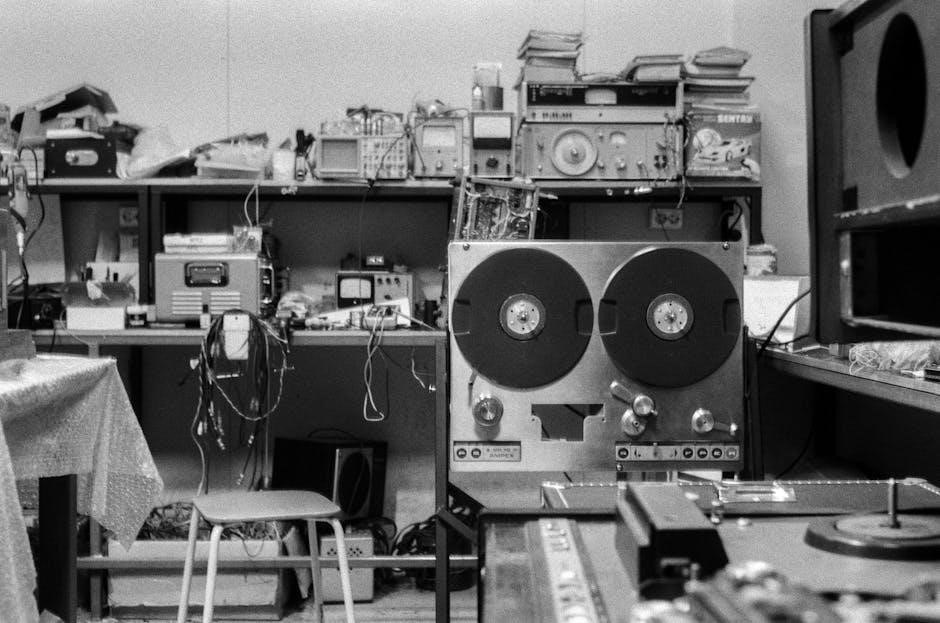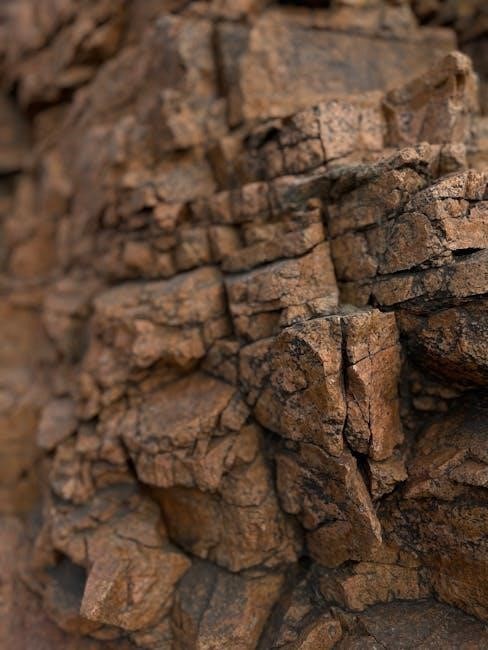A laboratory manual for physical geology is an essential tool for introductory geology courses. It offers hands-on activities, experiments, and exercises to explore Earth materials and processes. These manuals often include sections on mineral and rock identification, geologic history, and hazard mapping.
Overview of Physical Geology
Physical geology is the study of Earth’s materials, structures, and processes. It examines the composition, behavior, and history of our planet. A laboratory manual for physical geology serves as a guide through these complex topics. It typically covers a wide range of subjects, from plate tectonics and mineral identification to the formation of mountains and the causes of earthquakes.
The manual aims to enhance understanding through practical applications, encouraging students to engage directly with geological concepts. By using laboratory exercises, students can develop skills in observation, data collection, and interpretation. This approach helps to bridge the gap between theoretical knowledge and real-world phenomena.
Furthermore, a well-designed lab manual emphasizes the relevance of geology to everyday life. It highlights the importance of understanding natural resources, assessing natural hazards, and mitigating human risks. By providing hands-on experience, the manual enables students to connect geological processes to their impact on society and the environment. The manual promotes critical thinking and problem-solving abilities relevant to both academic and professional pursuits.
Purpose of a Laboratory Manual
The primary purpose of a laboratory manual in physical geology is to provide a structured, hands-on learning experience that complements theoretical concepts presented in lectures and textbooks. It serves as a practical guide, enabling students to actively engage with geological principles through experiments, observations, and data analysis. The manual aims to foster a deeper understanding of Earth’s materials, processes, and history.
A well-designed laboratory manual facilitates the development of essential skills, such as mineral and rock identification, map interpretation, and the analysis of geological structures. It encourages students to think critically, solve problems, and apply their knowledge to real-world scenarios. The manual also promotes collaborative learning, as many exercises are designed to be completed in groups.
Furthermore, a laboratory manual enhances the student’s ability to visualize and interpret complex geological phenomena. By working with physical samples, models, and simulations, students can gain a more intuitive grasp of concepts such as plate tectonics, erosion, and the formation of natural resources. The manual bridges the gap between abstract theory and tangible experience, making geology more accessible and engaging.
Key Topics Covered
A comprehensive laboratory manual for physical geology typically covers a range of fundamental topics essential for understanding Earth’s composition, structure, and dynamic processes. These key areas often include mineralogy, focusing on mineral identification based on physical properties and chemical composition. Petrology, the study of rocks, is another vital topic, covering the classification and formation of igneous, sedimentary, and metamorphic rocks.
Geologic time and history form a crucial part of the curriculum, exploring relative and absolute dating methods to unravel Earth’s past. Students will learn about stratigraphy, the study of layered rocks, and how to interpret geologic maps to understand regional geology. The manual delves into structural geology, examining deformation processes, faulting, and folding.
Furthermore, the manual covers topics like plate tectonics, earthquakes, and volcanic activity, highlighting their impact on shaping Earth’s surface. Weathering, erosion, and sedimentation are discussed to understand landscape evolution. Finally, the manual examines Earth’s resources, including their formation and responsible usage. These topics are essential for a solid foundation in physical geology.
Minerals and Rocks Identification
A cornerstone of any physical geology laboratory manual is the comprehensive coverage of mineral and rock identification. This section equips students with the necessary skills to identify common minerals based on their physical properties. These properties include color, streak, luster, hardness, cleavage, and fracture. The manual provides detailed descriptions and illustrations of various minerals, along with practical exercises for hands-on identification.
Moving beyond minerals, the manual delves into the classification and identification of rocks. Students learn to distinguish between igneous, sedimentary, and metamorphic rocks based on their texture, composition, and mode of formation; The manual includes flowcharts and diagnostic tables to aid in rock identification, along with numerous examples of each rock type.
Moreover, the manual emphasizes the importance of using a hand lens and other basic tools to observe key features in minerals and rocks. Students are guided through systematic procedures for describing and classifying samples, fostering critical thinking and observational skills crucial for geological studies. This section provides a solid foundation for understanding the building blocks of our planet.
Geologic History Interpretation
Interpreting geologic history is a fundamental skill in physical geology, and laboratory manuals dedicate significant sections to this topic. These sections provide students with the tools and knowledge to unravel the past events that shaped the Earth’s surface. Students learn about relative dating principles, such as superposition, original horizontality, and cross-cutting relationships, which allow them to determine the sequence of geological events.
The manuals also cover absolute dating techniques, including radiometric dating methods, to assign numerical ages to rocks and minerals. Students explore the use of fossils as indicators of past environments and time periods, understanding how fossil assemblages can provide insights into the evolution of life and changing climate conditions.
Furthermore, laboratory exercises often involve constructing geologic cross-sections and maps, enabling students to visualize subsurface structures and interpret the geological history of a particular region. By analyzing rock formations, faults, folds, and other geological features, students develop the ability to reconstruct the sequence of events that have occurred over millions of years, fostering a deeper understanding of Earth’s dynamic past.

Earthquakes and Seismic Activity
Laboratory manuals in physical geology dedicate significant attention to earthquakes and seismic activity, providing students with a comprehensive understanding of these natural phenomena. These sections typically cover the causes of earthquakes, including plate tectonics, faulting, and volcanic activity. Students learn about different types of seismic waves, such as P-waves, S-waves, and surface waves, and how they are used to locate earthquake epicenters and determine earthquake magnitudes.
The manuals also explore the concepts of earthquake intensity and magnitude scales, such as the Richter scale and the moment magnitude scale, enabling students to assess the severity of earthquakes and their potential impact. Laboratory exercises often involve analyzing seismograms, interpreting seismic data, and mapping earthquake distributions to identify seismic zones and understand patterns of seismic activity.
Furthermore, students investigate the hazards associated with earthquakes, including ground shaking, landslides, tsunamis, and liquefaction. They learn about earthquake-resistant building techniques and strategies for mitigating earthquake risks. By studying real-world earthquake events and their consequences, students develop a deeper appreciation for the destructive power of earthquakes and the importance of earthquake preparedness.
Geologic Hazard Mapping
Geologic hazard mapping forms a crucial component of laboratory manuals for physical geology, equipping students with the skills to identify and assess potential geological risks. This section delves into various hazards, including landslides, floods, volcanic eruptions, and coastal erosion, emphasizing the importance of understanding their spatial distribution and potential impacts on human populations and infrastructure.

Students learn to interpret topographic maps, aerial photographs, and satellite imagery to identify areas susceptible to different hazards. They analyze geological data, such as soil types, rock formations, and fault lines, to assess the likelihood and severity of potential hazards. Laboratory exercises involve creating hazard maps using Geographic Information Systems (GIS) software, overlaying geological data with demographic and infrastructure information to identify areas at high risk.
The manuals also emphasize the importance of risk assessment and mitigation strategies. Students learn about various techniques for reducing the impact of geological hazards, such as building codes, land-use planning, and early warning systems. They explore case studies of past disasters, analyzing the factors that contributed to the severity of the event and evaluating the effectiveness of different mitigation measures. By engaging in these activities, students develop a comprehensive understanding of geologic hazard mapping and its role in promoting community safety and resilience.
Plate Tectonics
The plate tectonics section within a physical geology laboratory manual provides a foundational understanding of Earth’s dynamic processes. Students explore the theory of plate tectonics, learning about the structure of the Earth, the different types of plate boundaries, and the driving forces behind plate movement. This section emphasizes the evidence supporting plate tectonics, including the distribution of earthquakes, volcanoes, and mountain ranges.
Laboratory exercises involve analyzing maps of plate boundaries, identifying different types of plate interactions (convergent, divergent, and transform), and examining the geological features associated with each type. Students use models and simulations to visualize plate movement and understand the formation of features such as mid-ocean ridges, subduction zones, and rift valleys. They analyze seismic data to locate earthquake epicenters and determine the depth of earthquakes, providing insights into the processes occurring at plate boundaries.
The manual also explores the relationship between plate tectonics and other geological phenomena, such as volcanism, mountain building, and the formation of mineral deposits. Students learn about the Wilson cycle, which describes the opening and closing of ocean basins over geological time. By engaging in these activities, students develop a comprehensive understanding of plate tectonics and its role in shaping Earth’s surface and influencing geological hazards.
Modeling Earth Processes
This section of a physical geology laboratory manual introduces students to the concept of using models to understand complex Earth processes. Modeling allows for the simplification and visualization of natural phenomena, making them more accessible and understandable. The manual covers various types of models, including physical, mathematical, and computer-based simulations.
Physical models might involve constructing miniature volcanoes to simulate eruptions or creating stream tables to observe erosion and deposition processes. Mathematical models utilize equations to predict the behavior of systems, such as groundwater flow or the rate of radioactive decay. Computer simulations offer the most sophisticated approach, enabling students to explore scenarios involving plate tectonics, climate change, and other large-scale processes.

Laboratory exercises focus on designing and interpreting models. Students learn to identify the key variables in a process, develop a simplified representation, and test the model’s predictions against real-world data. They evaluate the strengths and limitations of different modeling approaches and understand how models can be used to make predictions and inform decision-making in areas such as resource management and hazard mitigation; Through these activities, students develop critical thinking skills and gain a deeper appreciation for the complexity of Earth’s dynamic systems.
Laboratory Equipment and Techniques
This section of the physical geology laboratory manual provides a comprehensive overview of the essential equipment and techniques used in geological investigations. It begins with an introduction to basic tools for observation and measurement, such as hand lenses, streak plates, hardness scales, and compasses. Students learn how to use these instruments to identify minerals, describe rock textures, and measure geological structures.
Advanced techniques are also covered, including the use of topographic maps, aerial photographs, and satellite imagery for analyzing landforms and geological features. Students are introduced to methods for collecting and preparing samples for analysis, such as thin section preparation for microscopic examination of rocks and minerals. The section also covers techniques for measuring physical properties of Earth materials, such as density, porosity, and permeability.
Laboratory exercises focus on hands-on application of these techniques. Students learn how to operate different types of equipment, interpret data, and draw conclusions based on their observations and measurements. Safety protocols are emphasized throughout the section to ensure that students are aware of potential hazards and follow proper procedures in the laboratory. By mastering these essential skills, students gain the practical experience necessary for conducting geological research and fieldwork.

